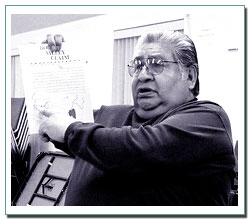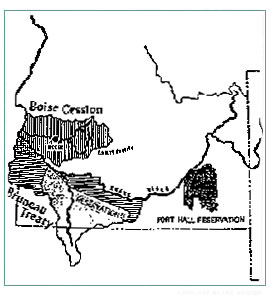
Edmo: Sovereignty exists because of land base
still exists on the rez
Taki: Hatcheries increase salmon numbers
Corless: Weiser Indians last to submit to 'rez' life
Interpretive Center will tell Sacajawea's story
By Crystl Murray Few people deny Native Americans inhabited Idaho before European settlers arrived. However, some deny the fact that Indians once inhabited the land that is now the stateís capital and the rights to that land are a subject of contention.
The Boise Valley Shoshone and Bannock tribes lived in the area now known as Boise and have never relinquished title to the land. They say their ancestors inhabited the land years before any Europeans came near it. They also claim those ancestors were there even after white men came to the valleys.
In 1862, gold was discovered in the Boise Basin, and white settlers flocked in growing numbers, creating tension between Indians and settlers. In 1863, Fort Boise was established by the U.S. government and manned by cavalry troops. Demands began that the Indians be removed.
In an effort to find a solution to Indian-settler relations, Idaho Territorial Governor and Superintendent of Indian Affairs Caleb Lyons signed a treaty with the Boise Shoshone.
The treaty stated that the Boise Shoshones would give up most of the valley. The only exception was a parcel of land 30 miles on each side from the center of the Boise River and to "all the country drained from its mouth to its source." An equal share of the fisheries was also promised. The treaty stated that both parties would agree to "deliver all horse thieves, murderers, and violators of laws," to the other.
The treaty also promised a sum of money that would be decided by Congress during ratification. The Boise Shoshones relinquished the land in good faith but the treaty was never ratified by Congress.
Two years later, Lyons signed another treaty with the Bruneau Shoshones in order to obtain mining lands around Silver City in the Owyhee Mountains. Local sentiment was critical of Lyonís dealings with Indians.
An article in the Idaho Statesman on March 17, 1866 included this opinion: "The idea is so ridiculous that any man outside of a lunatic asylum would think such a thing." The same article wasnít shy about how hated Indians were, "The loathsome sight of a few savage wretches is disgusting enough without having them in our midst by the hundred."
Once again, the Natives complied and the government did not.
Though the treaties were never ratified, they were still signed by an agent of the United States, and the Indians claim that the United States has no legal title to the Boise and Bruneau valleys.
Either by fear, force or by a need to survive, inhabitants of the Boise and Bruneau valleys relocated to present-day reservations. There were bounties varying from $25 to $100 offered to kill Indians seen near Boise at this time.
|
Lonnie Racehorse of the Shoshone-Bannock tribes said his late grandfather Charlie Diggie was conceived on Eagle Island near Boise. Diggie was 7 years-old when he relocated. "In April of 1869 all the Indians were rounded up from Weiser to Boise ó it was a trail of tears from the Boise Valley to here (Fort Hall)," he said. Out of the 500 Indians forced to make the trek, Racehorse said only 350 made it to Fort Hall. "It took a whole month to travel. It was a sad day." He said that those that were able to escape the cavalry went to either the Duck Valley Reservation or McDermitt, Nev. The story of this group was not uncommon throughout the United States and in 1946 Congress established the Indian Claims Commission. The commission was granted money from Congress to hear and decide on Indian land claims. One of the requirements of the commission was for tribal claimants to show that the treaty grossly underpaid their ancestors. Boiseís Shoshones were not paid anything. A claim was almost never filed because of years of poor legal advice. The group was told that different bands could not make one claim. Ernesto G. Sanchez, former attorney for the claimants, said in a publication complied on the Boise Valley Claim, "One thing is certain, this land still belongs to the Indians." With his help, they finalized a claim in the 1970s. The commission filed the claim for the wrong group, according to Idaho Historical records. By the time the error was recognized, the time for filing new claims had passed. In 1974, Orval Hansen, former U.S. congressman from Idaho, placed the claim in the Federal Register. More than 25 years later, no ancestors of the Boise Shoshones have received acknowledgement from the national government. Racehorse said the Boise Valley descendants do not want to "take over" downtown Boise. He said they want their "ancestral rights to the land and compensation." Fort Hall Business Council Chairman Blaine Edmo said the Boise Valley is still considered an open land claim: "It takes more research, along with hiring attorneys and technical experts willing to stand up for the descendants." There are few ways left for the Boise Shoshones to receive retribution. One would be special legislation passed by Congress to hear the claim. The other would be to sue the U.S. government. The Cayuga Indian Nation of New York state recently sued the government, and was awarded $248 million in U.S. District Court for a very similar claim. Idaho Gov. Dirk Kempthorne could not be reached for comment, and U.S. Sen. Larry Craigís office declined to comment. A spokesman said the office handles "strictly legislation," and this did not qualify. |
||||||||
|
|||||||||

